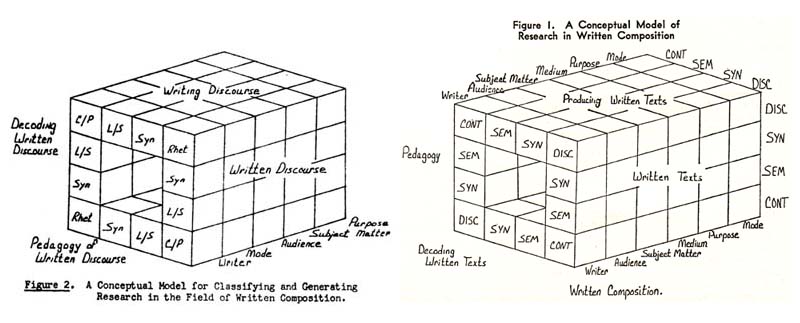| #19 Stephen Witte's Two Models for Research in Written Texts |
 |
|
Stephen Witte has been called an "empiricist," but doing so belies the eclectic grasp he had—and had early—of the whole field of composition studies. Consider these two diagrams, constructed a year apart. The first, on the left, illustrated a talk he gave at the Conference for Programs in Technical and Scientific Communication at Oklahoma State University in 1979, a talk he called "Procrustean or Paradigmatic: A Model for Research in Written Composition." The second, on the right, accompanied his 1980 Research in the Teaching of English revision of the talk, "Toward a Model for Research in Written Composition" (pp. 73-81). Both try to image the whole range of topics and questions open to composition research studies. Both insist on a view of the field that is three-dimensional or interdependent or, as Witte put it, "interactive configurally." Differences in the two diagrams show Witte moving toward a conception that is more rather than less complex. Both break the study of written composition into four main components—instruction (pedagogy), process (writing or producing), textuality (written texts), and hermeneutics (decoding)—here pictured as the horizontal plane. But to the features for study—pictured as the vertical right-facing plane—to writer, audience, subject matter, purpose, and mode in the earlier diagram, the later diagram adds a sixth, medium (e.g., newspaper, computer). The largest changes from 1979 to 1980 are in Witte's four main arenas for research questions—the vertical left-facing plane. Syntactic (SYN) and lexical/semantic (L/S or SEM) remain the same, but rhetorical (Rhet) becomes "supersentential structures and operations of discourse" (DISC), and cognitive/psychological (C/P) becomes "situational or cultural context" (CON). The later diagram, even more than the earlier, encourages researchers in composition to go beyond "instructional practice" and "explore new and perhaps uncharted areas" ("Toward a Model," p. 73). Four years later Witte helped usher in the first issue of Written Communication, which for the next twenty years under his co-editorship did more to expand the formal study of written texts into "uncharted areas" than any other professional journal. In the last few years he was researching and writing in areas such as activity theory, material rhetoric, and Vygotskian discourse. One of his last pieces (co-authored with Christina Haas) is "Writing as Embodied Practice: The Case of Engineering Standards," a detailed ethnographic study that appeared in the Journal of Business and Technical Communications (2002). "Empiricist" indeed. To the loss of all of us, this week Stephen Witte passed away. When it came to unmapped terrain, he was always leaving the rest of us a little behind. RH, April 2004 |